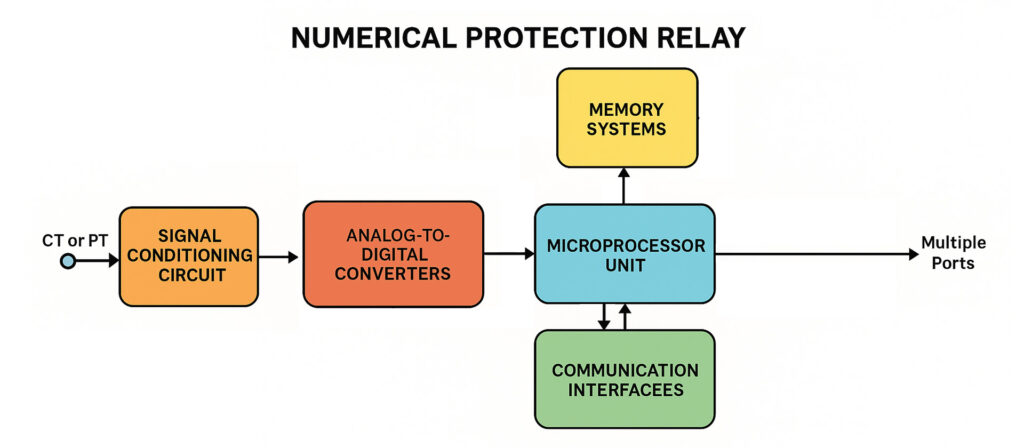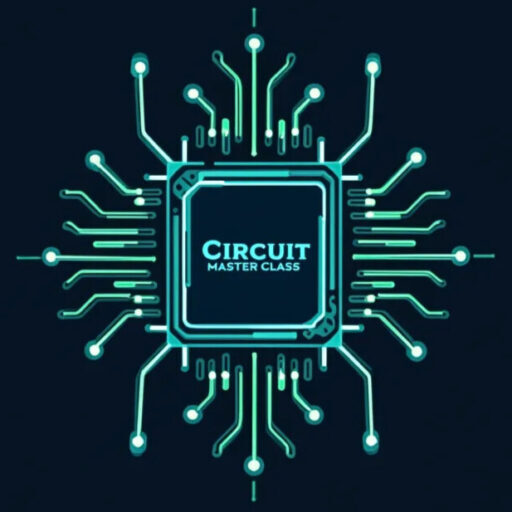A Numerical Protection Relay: Modern Power System Protection
A numerical protection relay is a breakthrough in power system protection technology. Unlike electromagnetic relays and static relays, this relay uses microprocessor-based technology. It combines digital signal processing, advanced algorithms, and communication systems. Today, numerical protection relays form the backbone of modern power system protection schemes.
What is a Numerical Protection Relay?
Simply put, it is an intelligent electronic device (IED). A numerical protection relay uses microprocessors to detect problems in electrical power systems.
Here’s how it works. First, these relays continuously monitor voltage and current signals. Next, they convert these electrical signals into digital form using analog-to-digital converters (ADCs). Then, they process the data using mathematical algorithms. Finally, they determine the actual threshold level. When the signal crosses this threshold, the protective action begins.
Why is it Called a Numerical Relay?
This relay employs digital signal processing. The term “numerical” refers to digital computation. Therefore, we use this term to distinguish these relays from analog-based protection relays.

Architecture of a Numerical Relay
Hardware Architecture
A typical numerical relay consists of several critical components. Let’s examine each one.
Signal Conditioning Circuit: First, the relay receives signals from a CT or PT. As the name suggests, a signal conditioning circuit scales down high-voltage and high-current inputs. Consequently, these inputs become suitable for electronic processing. Moreover, this circuit provides isolation between the power system and the relay’s internal electronics.
Analog-to-Digital Converters: Next, ADCs sample the low-scaled analog signals at high frequencies. Typically, they take 12-64 samples per cycle. Then, they convert these signals into digital values. As a result, the microprocessor can process them.
Microprocessor Unit: The CPU is the brain of the relay. It executes protection algorithms and performs calculations. Additionally, it manages communication protocols and coordinates all relay functions. Modern relays often use powerful 32-bit or 64-bit processors.
Memory Systems: The relay uses both volatile and non-volatile memory. RAM is volatile memory. Flash and EEPROM are non-volatile memories. Together, they store programs, settings, event records, and fault data.
Communication Interfaces: Multiple ports support various protocols. Therefore, the relay can integrate with SCADA systems, substation automation networks, and other IEDs.

Software Architecture
The software layer implements protection algorithms. These algorithms are based on various principles. For example, they include overcurrent, differential, distance, directional, and frequency protection. Furthermore, advanced features include adaptive protection, fault location algorithms, power quality monitoring, and self-diagnostic routines.
Advantages of a Numerical Protection Relay
Multi-functionality
A single numerical relay can perform multiple protection functions. Previously, you needed several separate devices for this. For instance, one relay can now provide overcurrent protection, earth fault protection, directional protection, voltage protection, and frequency protection simultaneously. As a result, panel space and wiring complexity are reduced significantly.
Superior Accuracy and Reliability: Digital processing eliminates many errors. Specifically, it removes errors from component aging, temperature variations, and mechanical wear. Consequently, numerical relays maintain their accuracy throughout their operational life.
Advanced Communication Capabilities: Modern numerical protection relays support multiple communication protocols. These include Modbus, DNP3, and most importantly, IEC 61850.
Comprehensive Recording and Analysis: A numerical relay provides excellent fault recording capabilities. It can capture signal waveforms, the sequence of events, and disturbance data. Therefore, engineers can analyze faults more effectively.
Self-Monitoring and Diagnostics: The relay continuously tests itself. It monitors its own health and detects internal defects. Hence, it can alert operators to potential issues before they compromise protection reliability.
Disadvantages of a Numerical Protection Relay
High Initial Cost: A numerical protection relay costs significantly more than a conventional relay. The cost includes the relay itself, communication infrastructure, configuration software, and specialized testing equipment.
Complexity in Configuration: Setting up numerical relays is not simple. It requires specialized knowledge of digital systems, communication protocols, and software tools.
Cybersecurity Vulnerabilities: Network connectivity creates risks. It exposes numerical relays to cyber threats like hacking and malware attacks.
Power Supply Dependency: A numerical relay needs continuous, stable DC power to operate. Without it, the relay cannot function.
Obsolescence Issues: Technology evolves rapidly. Consequently, hardware and software become obsolete quickly. The relay often requires firmware updates. Therefore, dependency on manufacturer support becomes essential. Additionally, software bugs can impact relay performance.
Specialized Training Required: Operating and maintaining numerical relays requires specialized training for engineers and technicians.
Complex Troubleshooting: Diagnosing faults in numerical relays is challenging. It requires specialized knowledge and equipment.
Environmental Sensitivity: Extreme temperatures and humidity affect the relay’s electronic components. Therefore, air conditioning in the relay room is essential.
Integration Challenges: International standards like IEC 61850 exist for connecting numerical relays. However, different manufacturers have their own special features. Unfortunately, these features don’t always work well with other brands.
Risk of Complete Failure: A numerical relay is an electronic device. Therefore, it can fail completely and suddenly due to component failure.
Network Dependency: IEC 61850 systems use GOOSE and sampled values. Consequently, protection schemes depend heavily on network reliability. Network failures, switch malfunctions, or fiber optic cable damage can compromise protection functionality across multiple devices.
Despite these disadvantages, numerical relays offer superior functionality and accuracy for modern power systems.
Final Thoughts
Despite these disadvantages, numerical relays offer significant benefits. Their superior functionality, accuracy, and flexibility generally outweigh the drawbacks. Therefore, they remain the preferred choice for modern power system applications.
Video on Numerical Protection Relay

